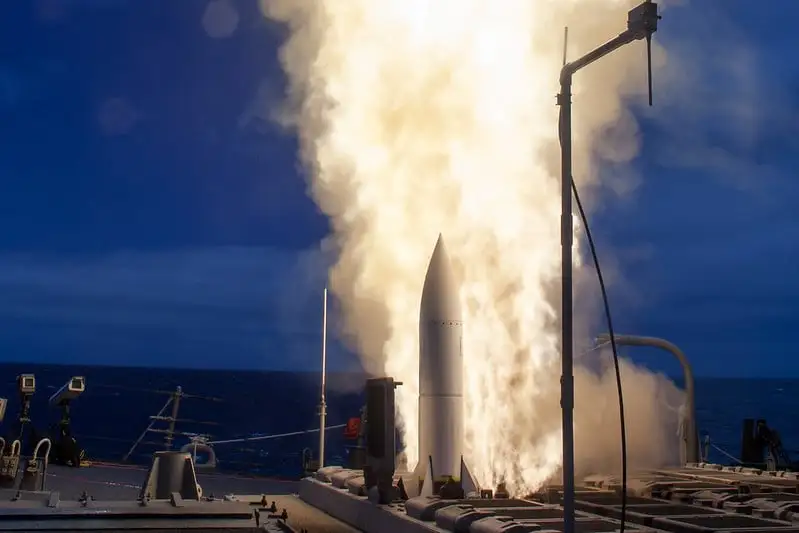Major Missile Sale Approved
The Trump administration has approved a significant arms deal with Japan, allowing the country to purchase up to 150 Standard Missile 6 (SM-6) Block I missiles. The deal, valued at approximately $900 million, also includes essential equipment, training, and technical support. This move is expected to boost Japan’s defense capabilities, particularly in response to growing security threats in the Indo-Pacific region. The Defense Security Cooperation Agency (DSCA) notified the U.S. Congress of the sale, marking a step forward in strengthening military ties between the two nations.
What Is Included in the Deal?
In addition to the 150 SM-6 Block I missiles, Japan will receive:
– MK 21 Mod 3 Vertical Launch System (VLS) canisters for launching the missiles.
– Engineering and integration support to ensure the missiles work with Japan’s AEGIS-equipped warships.
– Test and handling equipment to maintain and operate the missiles effectively.
– Technical data, publications, and training for military personnel.
– Logistics and program support to sustain long-term missile operations.
The principal contractor for the project is RTX Corporation, based in Camden, Arkansas. While no offset agreement has been finalized, such arrangements may be negotiated between Japan and RTX.
Why Japan Needs These Missiles
Japan faces increasing threats from North Korea’s ballistic missile program, China’s military expansion, and regional instability. The SM-6 Block I missile will help Japan’s Maritime Self-Defense Force (JMSDF) enhance its air and missile defense. These missiles will be deployed on Japan’s AEGIS-equipped warships, strengthening the country’s ability to intercept and destroy incoming enemy missiles.
The SM-6 missile is a cutting-edge weapon capable of:
– Intercepting enemy missiles before they reach their targets.
– Targeting enemy aircraft and ships at long distances.
– Adapting to modern threats, including hypersonic missiles.
This purchase aligns with Japan’s goal of increasing its self-defense capabilities while contributing to regional security efforts led by the United States and allied nations.
—
U.S. Perspective on the Sale
The United States views Japan as a key ally in the Indo-Pacific region. This sale supports Washington’s foreign policy goals by improving Japan’s ability to defend itself and protect allied forces stationed in the region.
Officials emphasize that the deal:
– Enhances stability in the Indo-Pacific.
– Strengthens Japan’s contribution to regional defense.
– Does not impact U.S. military readiness, as no additional U.S. personnel will be stationed in Japan to support the program.
This missile deal follows other military collaborations between the two nations, including Japan’s recent increase in defense spending and joint military exercises with the U.S.
Regional Reactions and Implications
The missile sale is likely to draw reactions from China and North Korea, both of which have expressed concerns over Japan’s increasing military capabilities.
– China has previously criticized U.S. arms sales to Japan, accusing Washington of destabilizing the region.
– North Korea may view the deal as a threat to its missile program and could respond with more missile tests.
However, U.S. and Japanese officials argue that Japan has the right to defend itself, especially given the rising security challenges in the region.
What’s Next?
The U.S. Congress will review the sale, though it is expected to be approved without major opposition. Once finalized, Japan will begin integrating the SM-6 missiles into its naval defense system, enhancing its ability to counter modern threats from air, land, and sea.
This deal marks another milestone in U.S.-Japan defense cooperation, reinforcing their strategic alliance in the Indo-Pacific. As tensions in the region continue to rise, Japan’s investment in advanced missile technology will play a crucial role in maintaining peace and stability.
This missile deal marks a significant step in strengthening Japan’s defense capabilities and reinforcing U.S.-Japan military cooperation. As regional tensions continue to evolve, the integration of advanced weapon systems like the SM-6 will enhance deterrence and provide greater security for Japan and its allies. This agreement also underscores the growing importance of strategic partnerships in maintaining stability across the Indo-Pacific region.

